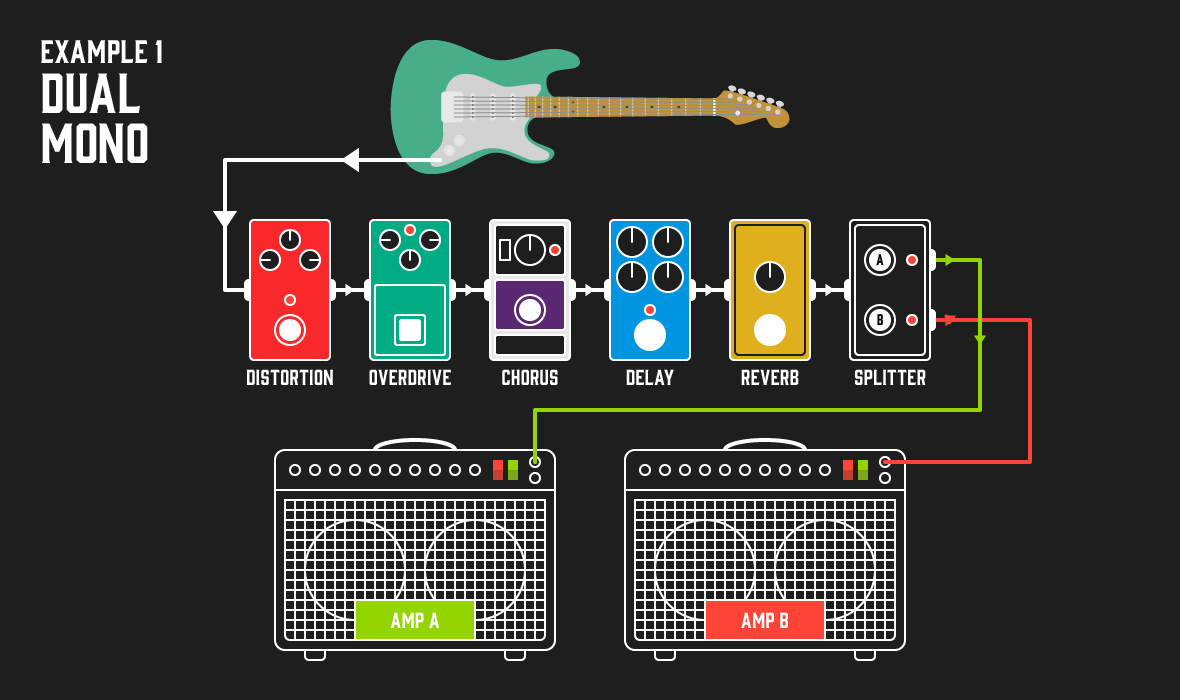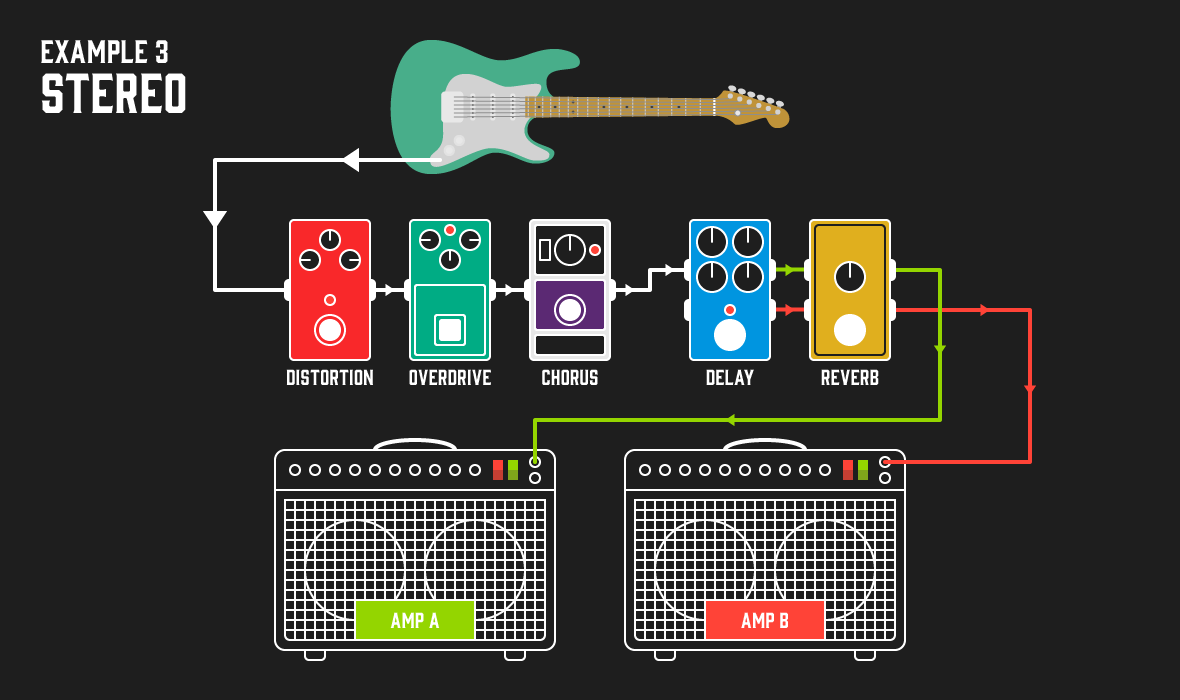- Essentials you need for a stereo guitar rig
- How do you set up an ABY pedal?
- Let’s talk amps
- Dual mono setup
- Wet/dry setup
- True stereo setup
- Stereo modelling rigs
- So… should you get a stereo amp rig?
The secret to many guitarists’ huge sounds is running multiple amplifiers in their rigs, either to combine different amplifiers to create a unique tone, or to add additional space and dimension to their sound using stereo effects. There are three main ways to set up a stereo amplifier rig, being dual mono, wet/dry, or true stereo. All have their own unique sounds and capabilities, which I’ll cover in this guide.
Essentials you need for a stereo guitar rig
- A Guitar
- 3 Cables
- Splitter / ABY Pedal or Stereo Pedal (and pedal power supply if required)
- 2 Amps
How do you set up an ABY pedal?
For the simplest of stereo rigs there’s a couple of things you’ll need: two amps, and a way to split your signal – that could be by using an ABY switcher or a stereo pedal with two outputs to split your signal to both amps. With your splitter, simply plug your guitar into the input of the pedal, then plug the two outputs to the input of two different amps.
ABY & Switcher Pedals
Shop All ABY & Switcher Pedals
Let’s talk amps
There are many different ways to run a stereo rig, but the simplest (and in my opinion best) way is to pick two amps of a similar headroom – which in general will mean a similar wattage. Bear in mind that solid state and valve amps produce vastly different volume and headroom at the same power. As a rule of thumb, a valve amp of 15W or more will probably need to be paired with a solid-state amp of 50W or more.
Why wattage matters
It’s all about headroom when it comes to balancing a stereo rig, which is the amount of clean volume the amp produces before it starts to overdrive. This is because you ideally want to run both amps at the same volume at similar gain levels, so the sounds complement each other rather than one dominating the other. This becomes especially important if you want to add gain pedals into the mix. If you decided to pair a super high-headroom 100W amp like the Victory V140 Super Duchess with a low-headroom 1W amp like a Marshall DSL-1, then the moment you stepped on a distortion pedal, the Victory with all that headroom would jump in volume, whilst the Marshall – which has far less headroom – would be pushed over the limit and would only produce more gain without a measurable increase in volume. So suddenly, your amps which were perfectly matched in volume and gain will be thrown entirely out of balance as one becomes much louder, and one is much quieter and more distorted.
Which amps pair well?
Provided your amps are roughly matched in power, this is really all down to you, and what kind of sound you’re going for. Many guitarists will pair two of the same amp, because they like that sound but they’re just looking to add more width and texture, while others will combine different amps to find their own unique tone.
A great starting point would be to try pairing any of the big three amp brands: Fender, Marshall and Vox. All have their own unique characteristics that compliment each other in a variety of ways.
Fender & Marshall: complimentary frequencies
Perhaps the most popular combination of British and American tone is Fender and Marshall, famously used by Stevie Ray Vaughan and more recently demonstrated by Simon Neil of Biffy Clyro. The EQs of these two amps are excellently suited to each other, as Fenders amps are known for their mid-scooped tone with plenty of bass and top end sparkle, while Marshall amps have a very mid-focused character that can sound very aggressive when cranked up. Together they fill in where the other lacks, so you still get the warmth and chime of the Fender with the punch of the Marshall.
Vox & Marshall: “mid-stacking” punch
For something dirtier, a Vox and Marshall could hit the spot. Both amps sound great when they’re overdriving as their midrange character adds fullness and punch. This idea of “mid-stacking” is a trick used by Joe Bonamassa to get his huge sounds. The idea is to find amps that are mid-focused, but accentuate different parts of the midrange, to create a really full effect that sits perfectly in the guitar’s frequency range. Marshall amps have a lot of lower midrange which gives them their characteristic punch, while a Vox is very upper mid focused when it starts to overdrive, giving it grit and cut.
But don’t feel limited to these options, try pairing any two amps you like and find your unique sound!
What is phase and why does it matter?
As previously alluded, provided that a chosen solid-state amp can match a valve amp for headroom, they can work perfectly well together in a stereo setup, but you can run into issues combining a solid state or valve amp with a digital amp. This is because digital amps experience an almost imperceptible amount of latency as your signal is converted from digital to analogue, which when paired with an all-analogue amp, would put the two signals out of phase with one another.
If two amps are out of phase, the sound you hear will be very thin and quite shrill – not a very pleasant sound. So remember, pair analogue with analogue, or digital with digital – don’t mix and match.
Dual mono setup

Dual Mono is perhaps the simplest stereo setup, as you’re sending the same signal to both amps, so the splitter goes at the end of your chain. What you get with this setup is extra width and tonal blending in your overall sound, but the effects remain the same out of both amps. For example, if you activate a tremolo, you won’t get a bouncing effect – it’ll produce the same on both sides.
The main benefit of this setup is simplicity. If you’re not interested adding stereo effects pedals and you’re just looking to blend the frequencies of the two amps to compliment one another, this method is for you.
Make sure to roughly match volume and gain so that adding gain pedals won’t result in uneven jumps in volume.
Wet/dry setup

Wet/dry is a little more complicated than dual mono, but it creates crisp ambient textures while still delivering a clear, direct signal. The concept of wet/dry is that you send all of your “wet” effects such as reverb, delay and modulation to one amp, while the other amp receives your “dry” signal only containing overdrive, which remains dynamic and punchy. The great advantage to this setup is that you can heavily layer wet effects without your core sound getting washy or mushy, which can often be an issue when layering time-based effects.
If you use a wet/dry rig in a live or studio situation and mic both amps, the mix engineer can blend the wet and dry signals to taste. As a rule of thumb, use the amp with more headroom (usually known as a “pedal platform amp”) as the wet amp to ensure clarity in the wet effects. However there are no hard rules, so try both ways! Consider running your wet effects in the FX loop of one of the amps if you’ve got one. This gives you even more definition in your reverbs and delays and will sound just as the pedals were intended.
True stereo setup

The true stereo setup gets the most out of your best stereo effects. Many modern effects pedals feature stereo inputs and outputs, designed to send different effects to each side, adding width and unique variety across the two speakers. Strymon are a huge name in stereo effects, creating the likes of the Big Sky, Volante and Timeline – premium pedals with huge potential in sound production. Meris are another pedal company specialising in this department, producing synth-like tones from their cutting edge designs. Quality stompbox manufacturers like Walrus Audio, GFI System, Eventide Audio and Old Blood Noise Endeavours all make amazing stereo pedals for your tone-shaping desires.
In terms of dialling in your amps, the same guidelines apply. If you already have any stereo pedals, it is very simple to set up. place your stereo pedal(s) at the end of your signal chain and send the two outputs to your two amps, and enjoy creating a sea of ambient sounds.
Stereo modelling rigs
The latest modelling amp technology provides everything two amps and a splitter does in one package. The Neural DSP Quad Cortex, Line 6 Helix, Kemper Profiling Amp, Valeton GP-200 and all their variations are amp emulators packed with guitar effects and stereo outputs. Dial in your amp settings in two “patches” or “blocks” and send each signal to a dedicated output. With an amp modeller, you can achieve any of the stereo setups depending on where you place each block in the signal chain.
Want to run a wet/dry setup? Easy – keep all your wet effects in one chain. Want to load up a ton of different effects for both amps? Done. Picking up a modelling amp is likely the best course of action for gigging guitarists because it makes travelling and setting up at shows that much quicker and easier. Plug your modeller into the front of house and you’re there – no heavy amps, or two in this case for a stereo rig, to lug around. For the tone purists valve amps are still the way to go. Unpowered modellers require a power amp if you wish to plug into amp cabinet speakers, otherwise you’ll have to run the signal into FRFR speakers or your audio interface.
So… should you get a stereo amp rig?
With two amps, there are so many ways to set them up to great a huge variety of different sounds. If you already have two amps, why not try a few different ways to set them up and find what your like – all you’ll need are two cables and a splitter, either as an ABY pedal or stereo guitar pedal (it’s a great excuse to buy a new pedal).
If you currently have one amp and you’re searching for more texture, depth or intricacy to your tone and effects, getting a second may be the perfect solution. And remember, there are no right answers, try experimenting until you find a sound that truly connects with you and your sound and style.
Enjoyed this read? We’ve collated some more relevant articles for you to check out:



Responses & Questions